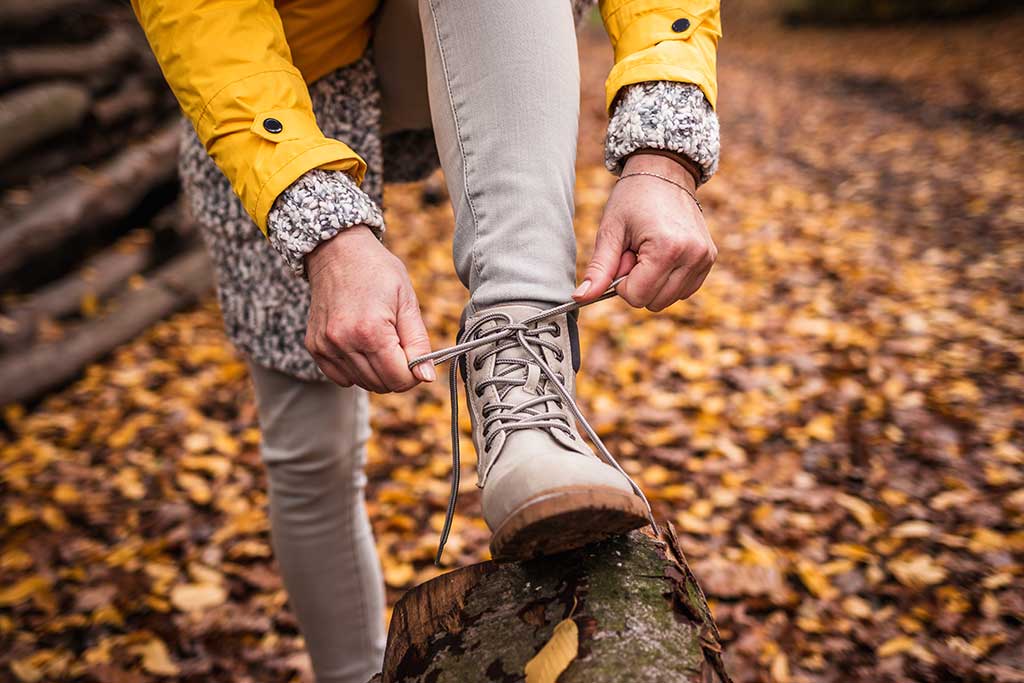What types of lacing are recommended for hiking shoes?

Choosing the right type of laces for your hiking boots can make all the difference to your outdoor experience. Whether you're a beginner or an experienced hiker, there are several lacing techniques to discover: classic lacing, cross lacing and loop lacing.
Each of these methods offers specific advantages in terms of stability and support, comfort, fit and ease of use. Understanding these differences will help you optimise your performance and well-being on the trails.
To guide you in this choice, we also offer practical advice on adapting lacing to suit the terrain, preventing blisters and pain and a few tips for long-lasting lacing. Get ready to discover the secrets of effective lacing to get the most out of your hikes.

Types of lacing for hiking boots
Hiking requires footwear that offers both comfort and stability. The choice of lacing type can significantly influence your experience on the trails. Let's explore the different types of lacing recommended for your hiking adventures.
Classic lacing
The classic lacing, or ‘over-under’, is the most common and consists of alternating the laces passing above and below the eyelets. This type of lacing distributes pressure evenly over the foot, ensuring a balanced fit. Ideal for light hiking, it offers simplicity of execution while effectively holding your shoe in place.
Cross lacing
Have you ever tried cross lacing? This style, also known as ‘criss-cross’, features regular criss-crossing of the laces between each pair of eyelets. It provides extra support, which is particularly useful when hiking over rough terrain. By distributing pressure evenly, this type of lacing minimises friction points and helps prevent blisters.
Loop lacing
For those looking for an ultra-precise fit, loop lacing, or ‘loop lacing’, could be your ally. By forming additional loops at strategic points on the foot, loop lacing allows you to tailor the fit to your specific needs. For example, if you tend to feel excessive pressure on the instep, creating a loop in this area can effectively relieve this tension.
The importance of the right choice of lace shouldn't be underestimated either. Flat or round laces can have their own advantages, depending on their material and elasticity. So, which will be your next choice to maximise your comfort during your nature escapades?
Advantages and disadvantages of the different types of lacing
When it comes to choosing the type of lacing for your hiking boots, each method has its own advantages and disadvantages. Whether you're a seasoned hiker or an amateur backwoods walker, it's essential to understand how each type of lacing can affect your comfort and performance on the trails.
Stability and support
The classic lacing, with its simple zigzag pattern, offers decent stability for light hiking. However, if you're looking for superior support for rough terrain, cross lacing, also known as cross lacing, could be your best ally. This type of lacing distributes pressure evenly over the whole foot, reducing the risk of sprains. On the other hand, it can be harder to adjust quickly on the move.
Comfort and fit
For those who value comfort above all else, loop lacing, or ‘loop lacing’, is an option to consider. This style provides a precise fit around sensitive areas of the foot such as the instep and ankles. Imagine climbing a mountain without feeling any excessive pressure or unpleasant friction: that's what this technique promises! However, it does require a little more time to set up correctly.
Easy to fit and adjust
If you prefer a quick and effective solution, classic lacquering is still unbeatable. Easy to do, even in pouring rain or with thick gloves, it allows quick adjustments without having to undo the laces completely. But be warned: its simplicity may not offer the sophisticated level of adjustment needed for technical hiking.
So, each type of lacing has its own specifics that can adapt to different needs and situations. Whether it's maximising your stability on rocky trails with cross lacing or ensuring optimum comfort with loop lacing on a long summer hike, choosing the right type of lacing can transform your wilderness experience.
Practical tips for lacing up when hiking
When it comes to hiking, the lacing of your footwear plays a crucial role in your comfort and performance. Good lacing can prevent blisters, provide optimum support and adapt to changing terrain. Here are some practical tips to make sure your laces are always up to scratch.
Adapting lacing to the terrain
Each type of terrain requires a specific lacing technique. On steep or rocky trails, opt for cross lacing, which offers greater stability and reduces lateral foot movement. For flat terrain or long walks on marked paths, classic lacing will be more than sufficient, providing both comfort and flexibility.
Preventing blisters and pain
Blisters can ruin a hike in no time. To avoid them, make sure your laces are neither too tight nor too loose. Use ‘lock lacing’, also known as ‘loop lacing’, to secure your heel and prevent slipping inside the shoe. This type of lacing creates a kind of anchor around the instep, reducing excessive friction.
Tricks for long-lasting lacing
During a long hike, it's not uncommon for laces to loosen over time. To avoid this inconvenience, opt for polyester or braided nylon laces, which offer greater resistance to wear and stay firmly in place. Also, remember to check your lacing regularly during your breaks to adjust if necessary.
Here are a few more tips:
- waxed laces: they slip less easily and hold their position better;
- double knot: a simple double knot can make all the difference in terms of safety;
- elastic laces: ideal for those looking for a quick fit without compromising on support.
Don't forget that every foot is unique! Don't hesitate to experiment with different lacing techniques to find the one that suits you best. Good preparation is synonymous with a successful hike.
We recommend these other pages:
